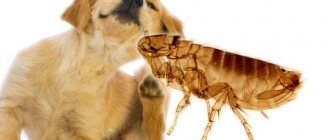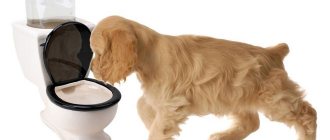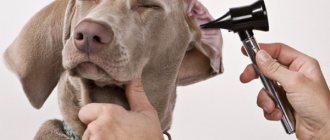Fleas are a problem that a breeder must face, no matter whether he has a dog or a cat. These parasites are considered the safest compared to others, but, nevertheless, they are capable of transmitting infectious diseases, viruses and being a source of allergic reactions.
You definitely need to fight them, otherwise they can give your pet internal parasites or even cause anemia.
Why are fleas dangerous?
The most common problem associated with flea bites is flea allergic dermatitis (FAD), manifested by itching, excessive shedding, hair loss and even baldness. Dogs suffering from itching become less obedient and irritated.
A common complication of flea allergy dermatitis is pyoderma, a bacterial skin infection in which the skin may become red, moist, sticky, crusty, and pustular.
Treatment of a bacterial infection can be lengthy, and bacteria may develop resistance to antibiotics. Small dogs may develop anemia (anemia) due to constant blood loss associated with feeding on a large number of fleas. There is evidence that up to 700 fleas were found on one dog! In addition, fleas are carriers of the helminth – cucumber tapeworm (Dipylidium caninum), which develops in the small intestine of animals (including dogs and cats) and humans. Infection occurs through accidental ingestion of infected fleas and their larvae. Small children who play on the floor in a room with a flea-infested dog are often infected.
Where do fleas come from?
A distinctive feature of fleas is their unique jumping ability, which allows them to easily move through their environment. The flea is capable of jumping up to 50 - 70 cm and up to a meter in the horizontal direction! Being in the environment, with the help of antennas sensitive to temperature and vibration of air flow, the flea is able to find a dog, even if it passes a meter away from it.
The flea life cycle, including eggs, larvae and pupae, occurs in the environment, usually close to the dog's habitat (bedding, carpets, floor cracks, soil surfaces and dust). Flea pupae can survive in a cool, dry room for 6 months to a year. When favorable conditions occur, adult fleas quickly hatch and land on the dog. Thus, fleas found on dogs are only 1–10% of the entire flea population in the animal’s environment.
Adult insects spend most of their lives on their host; only 3–8% of adult fleas move from one animal to another. Therefore, the main source of infection is the environment.
Important conditions to resolve the problem
Important conditions for eliminating parasites include:
- Once fleas are discovered, action must be taken to eliminate them as soon as possible. If you hesitate, then after 1.5 weeks their number can increase up to 10 times.
- When choosing a product, it is recommended to consult a veterinarian, who will select the best option for the animal depending on its condition and age.
- It is very important to follow the instructions for the drug exactly - this will avoid poisoning and other health problems.
It is important to use an integrated approach to flea removal: you need to not only treat the pet itself, but also the room. It is recommended to combine industrial insecticides and traditional methods.
How to tell if a dog has fleas
According to the experience of veterinarians, it is difficult to detect these fast parasites on a dog, although once they get on a dog, adult fleas spend 90% of their time on the body of their owner. Usually, a careful inspection will reveal only a few fleas on areas of skin with sparse fur, such as a dog's belly. You can also comb your dog with a fine comb, however, catching these insects is quite difficult.
A simple way to prove a flea infestation on a dog is to use a wet paper test to detect their feces. To do this, the dog is placed on damp white paper or cloth and combed with a comb. The appearance of black grains on the paper, giving a brown-red halo around, confirms the presence of fleas.
Since allergies to flea saliva often develop, even a single flea bite can cause debilitating itching in a dog, while the parasites themselves may not be visible. In this case, antiparasitic treatment is carried out using a flea remedy for dogs for diagnostic and therapeutic purposes.
The most effective way to kill insects
To quickly get rid of parasites, you should approach the issue comprehensively. It is recommended to use several products at once. For example, it is better to wash your dog with a special anti-parasitic shampoo. After bathing, it is recommended to rinse with a decoction of wormwood and a product based on apple cider vinegar.
If you are poisoning insects from a pet living with you in a house or apartment, then it is worth carrying out pest control. Parasites prefer to hide in carpets, upholstered furniture and other cozy places during persecution. Therefore, after treating your pet, clean the house: vacuum, beat and wash carpets and capes. It is advisable to treat the house with special products or call exterminators. If you don't do this, the insects will quickly return to your pet.
Flea larvae
When faced with the problem of flea allergy dermatitis, many owners wash their dog with anti-parasitic shampoo. This measure allows you to get rid of only a small part of the flea population, and the presence of larvae and pupae in the environment allows the dog to become infected again and again. When the symptoms do not go away, the owners begin to look for ways to solve the problem; by searching for “flea larvae in a dog photo” in an Internet search, they find moving worm-like larvae of white or brownish-yellowish color, but do not find them on their dog. How to detect the main representatives of the flea population? Having hatched from eggs located in animal habitats (bedding, carpets, dust, sandy soil), the larvae molt, pupate and turn into adult parasites that again attack the dog. Thus, only adult fleas and their feces can be found on the animal.
Treatment of fleas in dogs, or how to remove fleas
This section will talk about how to rid your dog of fleas. Collars, shampoos, sprays, spot-on drops and tablets are used to control adult fleas. The choice of drugs is quite large, but the question of how to remove fleas from a dog remains relevant. Currently, veterinary pharmacies offer a wide variety of flea and tick medications for dogs. How to choose the right flea medicine for dogs? Anti-flea shampoos act quickly; immediately after washing, the owner can see large numbers of dead fleas. It would seem that this is the most effective remedy. However, immediately after such a bath, the dog can become infected again through contact with contaminated bedding or carpet, or when going outside. Collars have a longer protective effect, however, the distribution of the antiparasitic component over inflamed skin can cause additional irritation at the site of contact of the collar. It is important to remember that the collar must touch the dog's skin tightly to distribute the active substance, which is sometimes difficult in dogs with long, thick hair. The choice of flea drops is also varied; it is worth choosing drugs with a low local irritant effect and having an “umbrella effect”, i.e. that help kill flea larvae in the environment, for example, Stronghold drops in the form of drops on the withers. Other forms of drugs active against fleas are tablets containing drugs from the isoxazoline group, for example, Simparica, which works against fleas and ticks for 35 days.
Effective treatment of flea allergy dermatitis involves not only killing adult fleas on the dog, but also treating the environment, for which sprays containing antiparasitic agents can be used, and a vacuum cleaner can also be of significant help. A prerequisite is to destroy the contents of the dust collector immediately after cleaning the room, since fleas and their larvae are mobile.
To relieve itching, symptomatic treatment is also prescribed, since itching may persist for some time, despite flea treatment. For this you can use Apoquel tablets. The drug is prescribed orally (with food or separately) at a rate of 0.4 - 0.6 mg/kg body weight twice a day, as long as there is itching, but not more than 2 weeks, then, if necessary, once a day. Apoquel is not recommended to be given to puppies under one year of age, to males during the mating period, to pregnant and lactating females, and to dogs with malignant tumors only under the supervision of a veterinarian. The drug is a low-hazard substance and is not a hormone or cytostatic; however, persistence of itching for more than two weeks after antiparasitic treatment requires additional diagnostics. Hormonal medications to control itching should only be prescribed by a veterinarian due to the presence of a large number of contraindications and the high likelihood of side effects.
Wet or crusty lesions are treated with antiseptics or the dog is bathed using antibacterial shampoos according to the instructions. In some cases, systemic use of antibiotics or creams containing antibiotics is necessary. This therapy is prescribed by a doctor.
Shampoos
Shampoo to protect your pet from fleas
An easy way to get rid of fleas is to use special shampoos. How often can you wash your dog with flea shampoo is a logical question. This can be done 1 or 2 times a month. It is recommended to use drops between washes. There are shampoos on sale based on natural ingredients and insecticides that quickly cope with the task. But they are toxic and can cause redness of the skin, so they should be handled carefully.
The following shampoos have proven themselves well:
- Phytoelite;
- Celandine;
- Doctor ZOO;
- Bio Groom et al.
One bottle can cost from 70 to 7,000 rubles, the price depends on the manufacturer, active substance, and packaging.
Flea treatment for dogs
How to get rid of fleas on a dog?
Once faced with a flea problem, owners hope to find the best flea treatment for dogs.
It is preferable to use drugs that, when applied to the dog’s skin, also help treat the environment and kill the flea population. What flea treatment for dogs has this “umbrella effect”? Such drugs include Stronghold in the form of drops on the withers. The drug is applied to intact dry skin at the base of the neck in a dose corresponding to the instructions for the weight of the animal every month. The drug is quickly absorbed from the skin, bathing with shampoo does not reduce its effectiveness, so the dog can be washed with shampoo within a couple of hours after applying Stronghold. The drug is not recommended for use in puppies under 6 weeks of age if the dog is hypersensitive to Stronghold. Treatment of pregnant and lactating females with Stronghold is permitted, but it is recommended that it be carried out under the supervision of a veterinarian.
Many, even experienced dog owners who regularly use the same flea and tick treatment for dogs, may encounter the problem of flea infestation in their dog, despite the treatment. Why is this happening? In some cases, the ineffectiveness of flea treatment is associated with an insufficient dose of the drug. Flea and tick medications for dogs should be used as directed. This is especially important to consider when treating puppies, whose weight can double during the period of action of the drug. Therefore, when treating puppies for fleas, it is recommended to use a drug that has low toxicity, the dose of which can be calculated based on the weight of the puppy by the end of the effect of the drug against fleas and ticks for dogs. Another reason for ineffectiveness of drop treatments is incorrect application of the drug. Most topical products spread over the dog's skin; running spot-on through the coat is ineffective. In addition, a product that has proven to be an effective flea treatment for dogs for many years may become resistant to fleas after some time.
Simparika, produced in tablets, which is an active drug against fleas and ticks, will help solve the above issues. The drug is quickly absorbed from the gastrointestinal tract and is low-hazard in terms of the degree of impact on the dog’s body. The drug is in the blood in a protein-bound state at a therapeutic concentration for 35 days. Bathing your dog with shampoo does not affect its activity against fleas and ticks. Contraindications are increased individual sensitivity to the components of the drug, age under 8 weeks, as well as severe renal and liver dysfunction and infectious diseases. As a rule, dogs voluntarily eat the tablet, since it has a liver taste that is attractive to the dog; eating the food does not affect the absorption of the drug.
Symptoms and external signs
If your puppy is itching, this does not always indicate fleas. The cause of itching may be a subcutaneous mite or an allergic reaction. You can suspect an allergy if the parasites themselves and traces of their vital activity are not visible. In order to make sure that your puppy has fleas, you can carry out simple express methods.
In the first case, you can wash your pet. Fleas do not like water, so they begin to actively run away, moving away from the water. In the second case, to detect parasites, you need to carefully comb the puppy's fur. It is recommended to use a special comb with thick teeth. Fleas reproduce quickly, so it is easy to see one or more fleas on an affected pet. Sometimes adult parasites are not visible, but traces of their vital activity are noticeable.
The owner must analyze how the puppy became infected with fleas. Very young pets become infected with parasites from their mother. But treatment of a female is allowed only after consultation with a veterinarian.
A specialist will help you choose an insecticide that has minimal harmful effects on the body of a lactating female. If the source of fleas is on another pet, comprehensive treatment is necessary.
Before you start removing fleas from your puppy, you need to take care of preparing the surrounding area. It is important to treat the sleeping area, all carpets and sofas with which the puppy has been in contact. Next, the insecticide is thoroughly washed off, preventing the possibility of poisoning the puppy. When treating the mother, she will also need to be isolated from the puppies for a while to prevent the puppies from licking off toxic substances.











